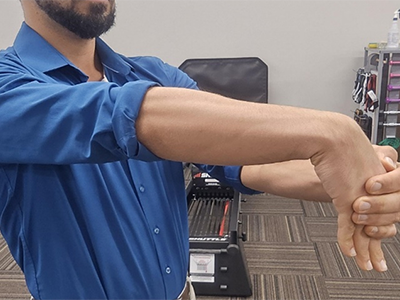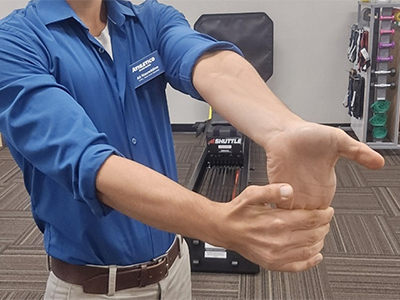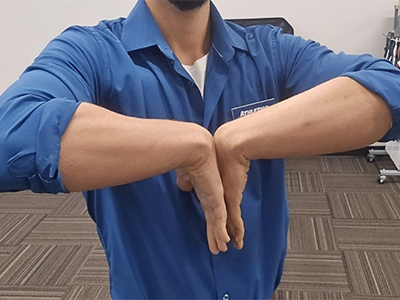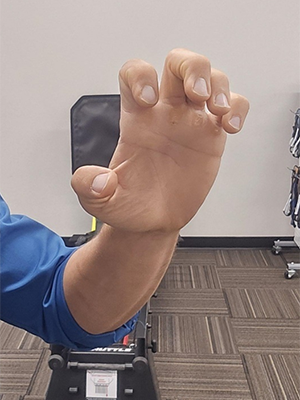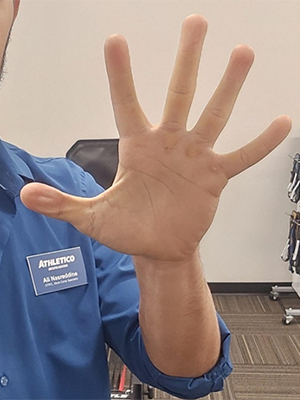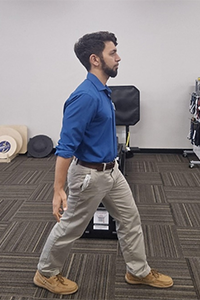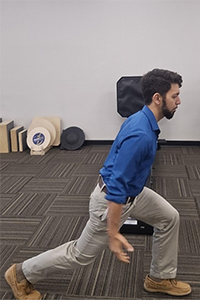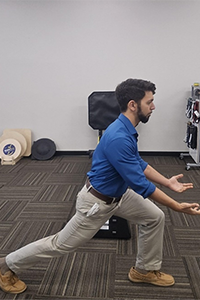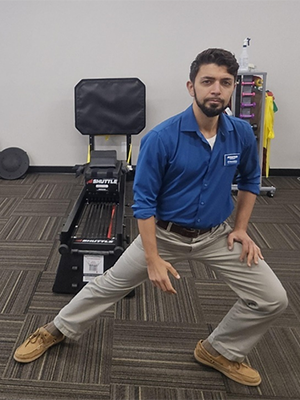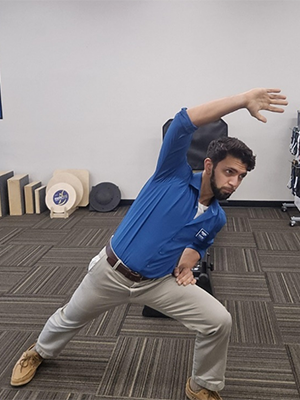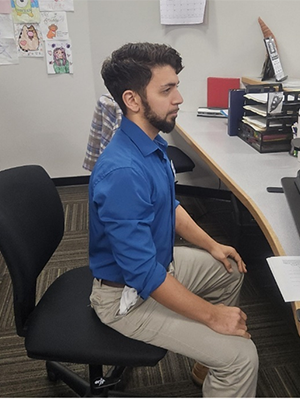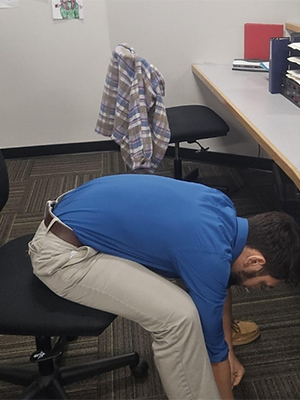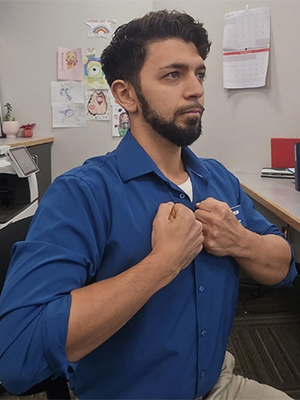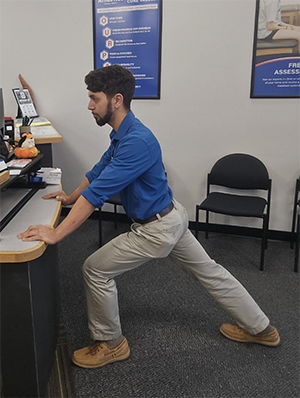
Impact of Ergonomics in the Workplace
Leave a CommentErgonomics is about how your surroundings and personal habits affect your risk of muscle and joint injuries. These injuries can happen in different parts of the body and may be caused by repeating the same movements, working in uncomfortable temperatures, or using poorly placed equipment. Stress and personal beliefs can also play a role, especially because these injuries often develop over time.
Active and Sedentary Roles
According to the Bureau of Labor Statistics, musculoskeletal disorders (MSDs) contribute 30% of all workplace injuries, in which truck drivers, healthcare workers, and warehouse (more active roles) are most prevalent by overexertion, equipment use or falling and tripping. Active roles can increase the likelihood of back, shoulder, hip, or knee pain. This may increase the potential for a dislocated shoulder, compression of the lumbar spine, or hip fracture.
In contrast, more sedentary roles (i.e., desk jobs) typically result in injuries such as tendinitis or tennis elbow, carpal tunnel syndrome (CTS), or cervical (and lumbar) pain. The positioning of equipment (i.e., office chairs, desk height) and lack of active movement lead to gradual overstretching and tightening of muscles in the cervical spine, lumbar spine, wrists, and knees.
Impact of Temperature
According to recent studies, temperatures beyond 90 degrees Fahrenheit (32 degrees Celsius) were found to be correlated with increased occurrence of heat stroke, heat stress, and workplace accidents when engaged in prolonged or strenuous tasks4. Prolonged exposure to cold temperatures without proper equipment or handling objects at high temperatures increases the risk of frostbite or burns.
Lighting
Lighting within the workplace may cause a shift in posture to compensate if lighting is too dim or insufficient. Lighting may cause serious injuries such as a slip and fall due to a spill on the floor with dim lighting and an increase in errors up to 30%5. Sedentary workplaces (i.e., desk jobs) are more prone to insufficient natural or overly bright fluorescent lighting, which may cause visual glares and straining of the eyes, reducing alertness, productivity, and job satisfaction5.
Noise
The likelihood of sustaining hearing loss, permanent tinnitus, or physical harm due to being unable to hear warning signals (i.e., factory worker) increases dramatically with heightened noise. For printing, plastic, or assembly line workers, prolonged exposure to ototoxic (or ‘ear poisoning) substances posed an even greater risk to hearing loss than increased noise in other settings6. Additionally, accidents due to difficulty distinguishing warning signals (i.e. reverse signal on lifting equipment) along with a prolonged exposure leading to increased stress carrying over into other areas of the workers’ life6.
Modifying Your Environment
Adjusting your environment to serve you better doesn’t need to be daunting. Taking time out of your day to shift positions, monitor your lifting or standing positioning, and slow down your movements are all within your control. Speaking with your supervisor about ergonomically friendly equipment (E.g., computer chairs, lifting equipment, desk dimensions) may be a first step. The same step may be taken for having ear plugs or increasing natural sunlight exposure into the workspace as both practical and cost-effective solutions.
Adjusting Your Outlook
You have more agency than you realize! Carrying our concerns from one environment to another gradually burdens our bodies. Dealing with strenuous mental or physical job demands can be managed by taking periodic breaks to slow down your breathing, segmenting large tasks into smaller portions, and alternating tasks to prevent the risk of repetitive injury. If your workspace is sedentary and involves sitting in front of a monitor all day, stand up and look out the window or go to the bathroom periodically. Taking a brief respite to stretch helps to re-calibrate yourself and be more present with the impact you provide for yourself and others.
Nine Stretches to Prevent Injury
1. Wrist Stretch
- Hold your arm to shoulder height with straight elbows and your palm facing the floor.
- Place your opposing hand over your knuckles.
- Press down to curl your wrist firmly.
- Hold at the endpoint for 10 seconds, and exhale slowly when breathing.
- Repeat three times with your palm to the ceiling.
2. Carpal Tunnel Stretch (Prayer Wrist Stretch)
- Begin with your palms clasped together in front of your chest.
- Keep the palms pressed tightly while lowering the hands toward your navel slowly.
- When the palms begin separating, hold the position for 10 seconds.
- Perform slow exhalations through diaphragmatic breathing
- Repeat three times.
3. Reverse Prayer Stretch (Wrist)
- Similar to the prayer stretch, press the back of both hands together.
- Raise both hands toward your chin, keeping contact with the back of both hands.
- Once the hands are unable to remain touching, hold for 10 seconds.
- Breathe slowly via exhalation and diaphragmatic breathing.
- Repeat three times.
4. Finger Stretch (Bear Claw)
- Begin with your hands and fingers open and spread apart.
- Curl your fingers and thumb at the mid-point as depicted.
- Hold for 10 seconds with slow diaphragmatic breathing and exhalation.
- Repeat three times.
5. Scoops (Lower Back Stretch)
- Begin with a staggered stance, lunging forward toward the front leg
- Bring your arms from your sides in front of you as if to pick up a big “bowl” with a scooping motion.
- Stoop down with the back leg, raising your arms before returning to the starting position.
- Repeat up to four times.
6. Lateral Lunge
- Begin by taking a large step to one side and leaning onto the leg that took a step.
- Take your opposite hand above your head to the same side as the leg leaned on (per depiction)
- Hold for 10 seconds, with slow exhalation on each breath.
- Return to the starting position and perform on the opposite leg.
- Repeat three times.
7. Forward Bend in Chair
- Begin by sitting in an office or standard chair, bending toward the floor with both arms.
- Hold the position until you feel you can’t move any further breathe in and out slowly.
- Return to the starting position slowly and repeat four times.
8. Chest to Shoulder (Superman Stretch)
- Begin by bringing both hands/arms across your chest.
- Straighten your elbows and bring your arms behind your back, squeezing your shoulder blades together.
- Hold for five seconds before returning to the initial position repeat four times.
9. Forward Lunge
- Place your hands on a stable surface, such as a table.
- Place your left foot forward with a slight bend in your knee.
- Keep your back leg straight as you lean forward into the stretch.
- Repeat on the other side.
What can I do about it?
At Athletico, our physical therapists are experts at helping injured workers return to work safely. To learn more about how we can help you or one of your employees, visit our Worker’s Compensation webpage.
References:
1. “Occupational injuries and illnesses resulting in musculoskeletal disorders” Bureau of Labor Statistics, May 1, 2020, https://www.bls.gov/iif/factsheets/msds.htm
2. “Workplace Safety and Health: OSHA Should Take Steps to Better Identify and Address Ergonomic Hazards at Warehouses and Delivery Companies” U. S. Government Accountability Office, October 8, 2024, https://www.gao.gov/products/gao-24-106413
3. “Contact with Objects and Equipment” National Safety Council, 2024, https://injuryfacts.nsc.org/work/safety-topics/contact-with-objects-and-equipment/data-details/
4. Spector J. T., Masuda Y. J., Wolff N. H., Calkins M., Seixas N. Heat Exposure and Occupational Injuries: Review of the Literature and Implications. Current Environmental Health Reports. 2019 Dec;6(4): 286-296. doi: 10.1007/s40572-019-00250-8. PMID: 31520291; PMCID: PMC6923532.
5. Rasouli K. Z., Jahangiri H., Smith A. P., Kazemi R. Subjective and Objective Survey of Office Lighting: Effects on Alertness, Comfort, Satisfaction, and Safety. Med Lav. 2022 June 28;113(3): e2022024. Doi: https://pubmed.ncbi.nlm.nih.gov/35766649/. PMID: 35766649; PMCID: PMC9437655
6. “The impact of noise at work” European Agency for Safety and Health at Work, 2005, https://osha.europa.eu/sites/default/files/Factsheets_57__Die_Auswirkungen_von_Larm_bei_der_Arbeit.pdf
